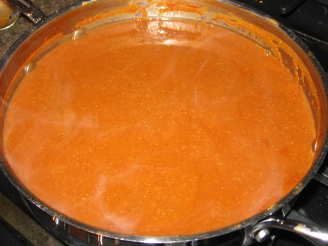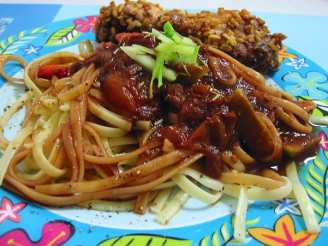Papa Kostrano's Red Sauce

- Ready In:
- 6hrs
- Ingredients:
- 23
- Serves:
-
20
ingredients
- 2 (28 ounce) cans diced tomatoes
- 2 (28 ounce) cans tomato sauce
- 1 (6 ounce) can organic tomato paste
- 1 large carrot, peeled, quartered lengthwise and cut into 1/2 inch pieces
- 1 stalk celery, halved lengthwise and cut into 1/2 inch pieces
- 1 small yellow onion, diced into 1/2 inch pieces
- 56 ounces cold water (just fill one of those empty tomato sauce cans two times)
- 1 -2 tablespoon extra virgin olive oil
- 3 -4 garlic cloves, finely minced (medium-large, depends on how much garlic you like)
- kosher salt
- fresh ground black pepper
- sugar (if necessary)
- 2 -3 tablespoons fresh basil, cut (That's chef-speak for roll the leaves into a cigar shape and slice very thin ribbons of basil)
- 2 -4 tablespoons fresh oregano, roughly chopped (start with 2, you can always add more if you want)
- 2 -4 tablespoons fresh flat-leaf Italian parsley, finely chopped (start with 2, you can always add more if you want)
- 1 -2 teaspoon dried basil (Start with 1 tsp., let sauce cook a bit, taste and add more if desired. Sometimes I add up to 3 tsp )
- 1 -2 teaspoon oregano (Start with 1 tsp., let sauce cook a bit, taste and add more if desired. Sometimes I add up to 3 tsp )
- 1 -2 teaspoon marjoram (Start with 1 tsp., let sauce cook a bit, taste and add more if desired. Sometimes I add up to 3 tsp )
- sea salt
- fresh ground black pepper
- 1 -2 bay leaf (Fresh is best, dried is perfectly fine)
- parmesan cheese, rind from a hunk of GOOD Parmesan cheese. I typically use a 6 x 4 inch piece
- organic unbleached cane sugar or baking soda
directions
- Add 1 Tablespoon of olive oil to a large stockpot or Dutch oven that was pre-heated over medium-high heat. Add diced veggies. Sprinkle with approximately 1/4 teaspoons salt and 1/8 teaspoons black pepper. Cook until veggies start to soften; about 5-7 minutes. If they start to brown, reduce heat to medium-low. Stir frequently.
- Next add the cans of tomato sauce, diced tomatoes, water, minced garlic, fresh herbs, dried herbs and bring to a lazy bubble over medium heat. Once your sauce starts to bubble, add the Parmesan cheese rind (or fresh Parmesan) and the can of tomato paste. Stir well to incorporate the cheese and reduce heat to lowest burner setting.
- Simmer the sauce for 3 hours stirring frequently to prevent burning. (I simmer mine total for at least 6-8 hours.).
- After 3 hours, taste sauce again and adjust the seasonings/herbs.
- Simmer the sauce for another hour. Using an immersion blender, whir the sauce until the pieces of tomato, carrots, onions and celery are blended and as smooth as you can get.
- If you don’t have an immersion blender you can use a normal blender, but only blend 2-3 cups at a time, and remove the center of the lid and place a folded kitchen towel over the opening to allow steam to escape, without burning your hand. Hot liquids will cause the cover to blow off and you’ll have a tomato-decorated kitchen and burned hands.
- Blend the sauce until it’s smooth.
- If you used a Parmesan cheese rind, the immersion blender will whir that into very small pieces, and after it’s cooked in the sauce for several hours, those little cheesy bits taste heavenly in the finished sauce.
- You may need to add a little more water once you return the blended sauce back to the sauce pot. The water will cook out; so don’t worry if you add too much you can cook it to your desired consistency. I prefer mine a little loose because it thickens up in the fridge.
- Once you’ve achieved the seasoning level you desire, (this is the point where you would add cooked homemade meatballs) continue to simmer for another 4-6 hours, stirring frequently and taking care to not let any sauce burn on the bottom of the pan.
- Remove the pot from the heat, and let it cool down as much as possible. Cover and refrigerate overnight. If you simply can’t wait a day while your sauce does magical things as it chills in the fridge, go ahead and serve it over some pasta.
- Notes.
- Seasoning: Each time you add an element; it is best to taste it for seasoning. Let it simmer/cook for a few minutes, stir well, taste, and then adjust seasonings. You may find you want to add a little more garlic, or another teaspoon of an herb.
- Parmesan Cheese Rinds: I use the rinds to flavor soups and sauces. If you don’t happen to have a spare rind sitting around, run to the store and buy a hunk of good Parmesan (please, don’t come home with that green canister of grated Parmesan) and toss in 1-2 ounces of Parmesan, either grated or cut into small chunks.
- Acidic Sauce: If your sauce seems very acidic, add a TB of good olive oil or butter and a ¼ to ½ teaspoons of baking soda and stir well. You can also add a teaspoon of sugar if you find your tomatoes are very acidic. The baking soda makes it more alkaline and the sugar cuts the acidity by making it a bit sweeter. Baking soda will cause your sauce to bubble for a bit, so make sure you start with a very low amount and taste after each addition.
- The sauce tastes much better after spending at least 12 hours in the chill chest (fridge)–I try to give it a good 24-36 hours in the fridge before using it for spaghetti or lasagna or shells.
Questions & Replies
Got a question?
Share it with the community!
Reviews
Have any thoughts about this recipe?
Share it with the community!




